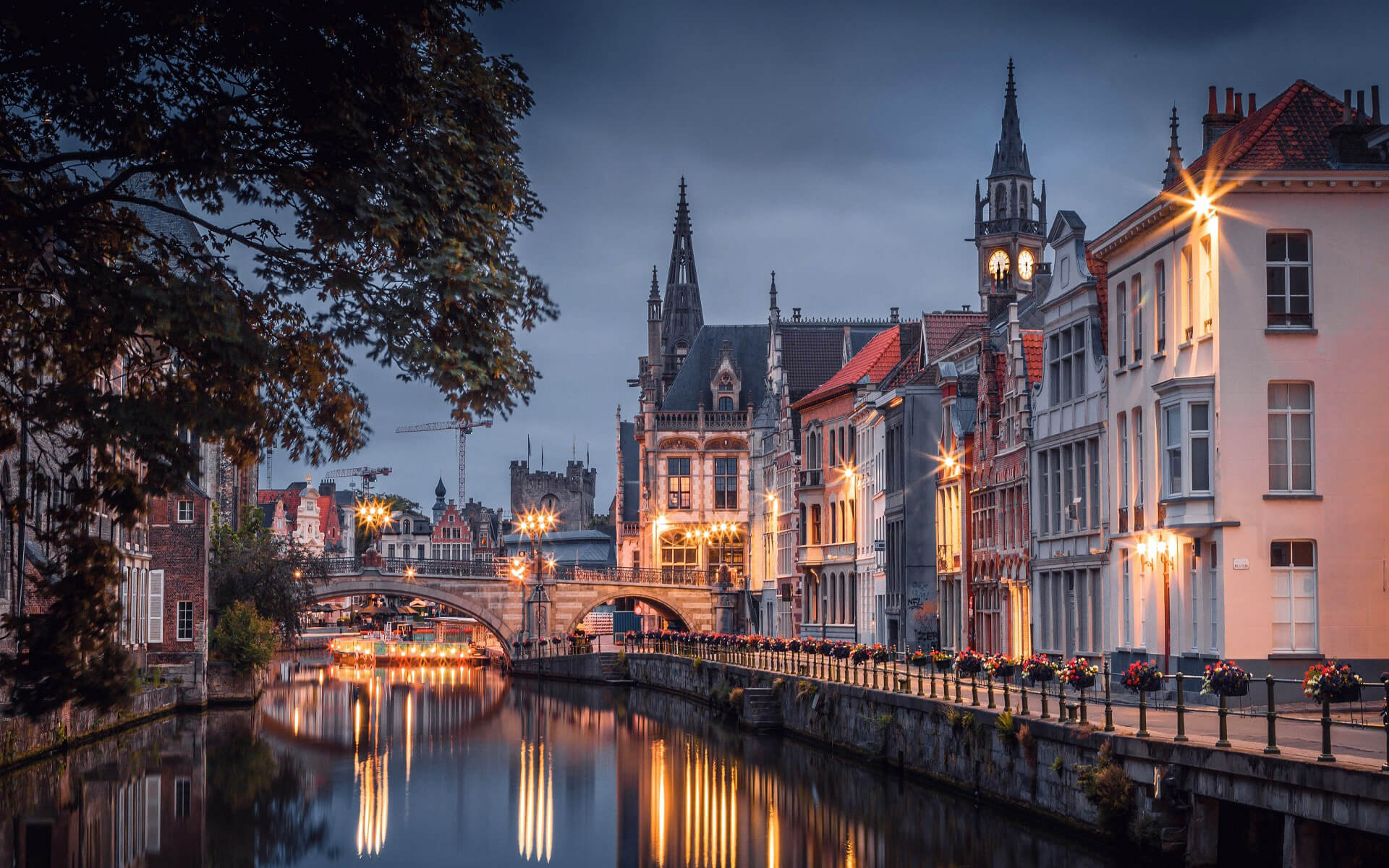Ghent (Dutch: Gent, French: Gand) is a Belgian city in East Flanders. Ghent is a city with a quarter-million people and a rich history. Ghent, on the other hand, has a comparatively high proportion of young people and a student population of 50,000.
Ghent was one of Europe’s wealthiest and most powerful towns throughout the Middle Ages. It was originally thought to be the second-largest city north of the Alps, behind Paris. Viewing the majestic architecture of churches and the homes of wealthy merchants reveals the influence of this rich history. The whole city center has been reconstructed in this manner, and it still exudes the feeling of a vibrant late-medieval city state. As a result of the city council’s decision to make the center car-free, it is today a highly welcome and open environment that impresses even the residents.
Unlike in Leuven, another university town in Flanders, youngsters are not the only ones who live there. Among the natives of Ghent, there is an unusual mix of foreigners who came to live there or artists. People become more tolerant and open-minded as a result of this blend. This attitude pervades all aspects of city life, more so than in smaller provincial cities or the larger metropolis of Antwerp.
ARCHITECTURE
Much of the city’s medieval architecture is still standing and has been meticulously conserved and renovated. Its central region is Belgium’s biggest car-free zone. The Saint Bavo Cathedral with the Ghent Altarpiece, the belfry, the Gravensteen fortress, and the magnificent buildings around the ancient Graslei port are also noteworthy. Ghent has achieved a great balance of comfort and history — it is not a city-museum. Ghent also has three béguinages and a number of churches, including the Saint-church, Jacob’s the Saint-Nicolas’ church, and the Saint-church. Michael’s
Louis Roelandt, Ghent’s most renowned architect, created the university hall Aula, the opera building, and the main courtroom in the nineteenth century. The university buildings (the Boekentoren or Book Tower) by Henry Van de Velde are notable examples of contemporary architecture. There are also a few theatres from various eras.
In 1998 and 1999, UNESCO designated the beguinages, as well as the belfry and adjacent cloth hall, as World Heritage Sites.
Ghent also has the Zebrastraat, a social experiment in which a totally refurbished location integrates life, economics, and culture.
MUSEUMS
The Museum voor Schone Kunsten (Museum of Fine Arts) in Ghent houses paintings by Hieronymus Bosch, Peter Paul Rubens, and many Flemish masters; the SMAK or Stedelijk Museum voor Actuele Kunst (City Museum for Contemporary Art) houses works by Joseph Beuys and Andy Warhol; and the Design Museum Gent houses masterpieces by Victor Horta and Le Corbusier. The Huis van Alijn (Family House of the Alijns) was formerly a beguinage and is now a folk art museum with theatre and puppet presentations for children. The Museum voor Industriele Archeologie en Textiel, or MIAT, showcases Ghent’s industrial strength with recreations of 1800s workplaces and stores, as well as actual spinning and weaving machinery from the building’s previous life as a weaving mill. The Ghent City Museum (Stadsmuseum, abbreviated STAM) is dedicated to documenting and interpreting the city’s history and people, as well as conserving the present for future generations.
RESTAURANT TRADITIONS AND CULINARY TRADITIONS
Bakeries in Ghent and other East-Flanders districts offer a donut-shaped bun called a “mastel” (plural “mastellen”), which is essentially a bagel. “Mastellen” are also known as “Saint Hubert bread” since bakers bring their batches to the early Mass on the Saint’s feast day, November 3rd, to be blessed. It was formerly believed that blessed mastellen vaccinated against rabies.
Other local delicacies include praline chocolates from Leonidas, cuberdons or ‘neuzekes’ (‘noses’), cone-shaped purple jelly-filled candies, ‘babeluten’ (‘babblers’), hard butterscotch-like candy, and, on the hotter side, the famous ‘Tierenteyn,’ a hot but refined mustard with some affinity to French ‘Dijon’ mustard.
Stoverij is a traditional Flemish beef stew that is best when cooked with a big amount of brown ‘Trappist’ (strong abbey beer) and served with French fries. ‘Waterzooi’ is a local stew that was originally cooked from freshwater fish gathered in Ghent’s rivers and streams, but is now often made using chicken instead of fish. It is often served in a nouvelle-cuisine manner, with a huge pot on the side.
The city supports Donderdag Veggiedag, a meat-free day on Thursdays, with vegetarian cuisine promoted in public canteens for civil workers and elected councillors, in all city-funded schools, and promotion of vegetarian dining alternatives throughout town (through the distribution of “veggie street maps”). This effort is connected to the realization of the negative environmental consequences of meat production, which the Food and Agriculture Organization of the United Nations has determined accounts for roughly one-fifth of world greenhouse gas emissions.
Ghent has the most vegetarian restaurants per capita in the world.
FESTIVITIES
The Gentse Feesten, I Love Techno in Flanders Expo, “10 Days Off” musical festival, International Film Festival of Ghent (including the World Soundtrack Awards), and Gent Festival van Vlaanderen are all held in the city (nl). In addition, every five years, a massive botanical show (Gentse Floralin) is held at Flanders Expo in Ghent, drawing a large number of tourists.
In 2008, the Festival of Flanders celebrated its 50th anniversary. It begins in Ghent on the second Saturday of September with the OdeGand City celebrations. There are 50 performances in various sites around the historic inner city, with 250 international performers performing. Similar events are held in other major Flemish cities as part of the Festival of Flanders (Antwerp with Laus Polyphoniae; Bruges with MAfestival; Brussels withKlaraFestival; Limburg with Basilica, Mechelen and Brabant withNovecento and Transit).
NATURE
The city’s extensive parks might also be called tourist attractions. Ghent, in particular, has a natural reserve (Bourgoyen-Ossemeersen, 230 hectares) and a pleasure park (Blaarmeersen, 87 hectares).


